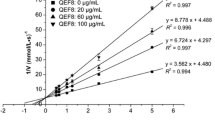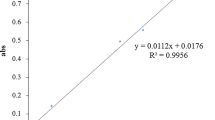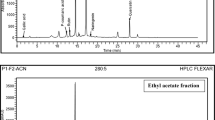Abstract
In the present work, Qingzhuan tea, a unique dark tea produced by post-fermentation technology, was selected to investigate its antioxidant and pancreatic α-amylase inhibiting activities. Water extract of Qingzhuan tea was successively isolated by solvent partitioning procedures to obtain chloroform, ethyl acetate, n-butanol, sediment and residual aqua fractions. Of different fractions, the ethyl acetate fraction (QEF) had the highest total polyphenols and catechins contents, demonstrated the strongest DPPH radical scavenging activity and exhibited the greatest inhibitory effect on porcine pancreatic α-amylase activity in vitro. Further separation of QEF by a Sephadex LH-20 column generated eight subfractions (QEF1–QEF8), with QEF8 being the most active subfraction based on the assays above mentioned. The major active components in QEF8 were identified as catechins EGCG and ECG by LC-MS analysis, with contents of 22.29 % and 11.11 % respectively. Inhibitory effects of catechin standards EGCG and ECG on porcine pancreatic α-amylase activity were also observed. In conclusion, Qingzhuan tea or its water extract could be potentially used as complementary therapy ingredients for diabetes treatment through lowering postprandial blood glucose, and catechins EGCG and ECG may be the most efficient components in the water extract.



Similar content being viewed by others
References
Al-Dabbas MM, Kitahara K, Suganuma T, Hashimoto F, Tadera K (2006) Antioxidant and alpha-amylase inhibitory compounds from aerial parts of Varthemia iphionoides Boiss. Biosci Biotechnol Biochem 70(9):2178–2184
Anesini C, Ferraro GE, Filip R (2008) Total polyphenol content and antioxidant capacity of commercially available tea (Camellia sinensis) in Argentina. J Agric Food Chem 56(19):9225–9229
Ani V, Naidu KA (2008) Antihyperglycemic activity of polyphenolic components of black/bitter cumin Centratherum anthelminticum (L.) Kuntze seeds. Eur Food Res Technol 226(4):897–903
Chen Y, Wang M, Rosen RT, Ho CT (1999) 2, 2-Diphenyl-1-picrylhydrazyl radical-scavenging active components from Polygonum multiflorum Thunb. J Agric Food Chem 47(6):2226–2228
Chen YQ, Zhang W, Cheng Q, Dong JF, Liu XH, Gan DP, Qian YP (2008) The anti-obesity effects of Hubei Qingzhuan tea on rats (Chinese). J Tea Sci 28(5):363–369
Chen YQ, Ni Dj, Cheng Q, Ma R, Kong LQ (2009) Study on the main components and capacities of scavenging free radicals of Qingzhuan tea. Proceedings of the Symposium on technological innovation and industrial development of Tea 427–432
Chen YQ, Zhang W, Ni DJ, Cheng Q, Liu XH, Gan DP (2010) Study on the hypolipidemic effect and antioxidative activity of Hubei Qingzhuan tea (Chinese). J Tea Sci 30(2):124–128
Chung FL, Schwartz J, Herzog CR, Yang YM (2003) Tea and cancer prevention: studies in animals and humans. J Nutr 133(10):3268–3274
Conforti F, Statti G, Loizzo MR, Sacchetti G, Poli F, Menichini F (2005) In vitro antioxidant effect and inhibition of α-amylase of two varieties of Amaranthus caudatus seeds. Biol Pharm Bull 28(6):1098–1102
Fu DH, Liu ZH, Huang JA, Chen HH (2008) The effect of different extracts of Fuzhuan tea on the activities of digesting enzyme (Chinese). J Tea Sci 28(1):62–66
Fukushima Y, Ohie T, Yonekawa Y, Yonemoto K, Aizawa H, Mori Y, Watanabe M, Takeuchi M, Hasegawa M, Taguchi C (2009) Coffee and green tea as a large source of antioxidant polyphenols in the Japanese population. J Agric Food Chem 57(4):1253–1259
Gilman AG, Goodman LS, Rail TW, Murad F (1985) The pharmacological basis of therapeutics. Macmillan, New York
Golay A, Schneider H, Temler E, Felber JP (1991) Effect of trestatin, an amylase inhibitor, incorporated into bread, on glycemic responses in normal and diabetic patients. Am J Clin Nutr 53(1):61–65
Gondoin A, Grussu D, Stewart D, McDougall GJ (2010) White and green tea polyphenols inhibit pancreatic lipase in vitro. Food Res Int 43(5):1537–1544
Halliwell B, Gutteridge JMC (1989) Free radicals in biology and medicine. Clarendon, Oxford
Hara Y, Honda M (1990) The inhibition of α-Amylase by tea polyphenols. Agric Biol Chem 54(8):1939–1945
He Q, Lv Y, Yao K (2007) Effects of tea polyphenols on the activities of alpha-amylase, pepsin, trypsin and lipase. Food Chem 101(3):1178–1182
Higdon JV, Frei B (2003) Tea catechins and polyphenols: health effects, metabolism, and antioxidant functions. Crit Rev Food Sci 43(1):89–143
Hosoda K, Wang MF, Liao ML, Chuang CK, Iha M, Clevidence B, Yamamoto S (2003) Antihyperglycemic effect of oolong tea in type 2 diabetes. Diabetes Care 26(6):1714–1718
Jie G, Lin Z, Zhang L, Lv H, He P, Zhao B (2006) Free radical scavenging effect of Pu-erh tea extracts and their protective effect on oxidative damage in human fibroblast cells. J Agric Food Chem 54(21):8058–8064
Karori S, Wachira F, Wanyoko J, Ngure R (2010) Antioxidant capacity of different types of tea products. Afr J Biotechnol 6(19):2287–2296
Kondo S, Tsuda K, Muto N, Ueda J (2002) Antioxidative activity of apple skin or flesh extracts associated with fruit development on selected apple cultivars. Sci Hortic-Amsterdam 96(1–4):177–185
Kusano R, Andou H, Fujieda M, Tanaka T, Matsuo Y, Kouno I (2008) Polymer-like polyphenols of black tea and their lipase and amylase inhibitory activities. Chem Pharm Bull 56(3):266–272
Layer P, Rizza RA, Zinsmeister AR, Carlson GL, Dimagno EP (1986) Effect of a purified amylase inhibitor on carbohydrate tolerance in normal subjects and patients with diabetes mellitus. Mayo Clin Proc 61(6):442–447
Ling TJ, Wan XC, Ling WW, Zhang ZZ, Xia T, Li DX, Hou RY (2010) New triterpenoids and other constituents from a special microbial-fermented Tea-Fuzhuan brick tea. J Agric Food Chem 58(8):4945–4950
Loo AE, Huang D (2007) Assay-guided fractionation study of α-amylase inhibitors from Garcinia mangostana pericarp. J Agric Food Chem 55(24):9805–9810
Ludwig DDS (2002) The glycemic index - physiological mechanisms relating to obesity, diabetes, and cardiovascular disease. Jama-J Am Med Assoc 287(18):2414–2423
Matsumoto N, Tonooka F, Ishigaki A. Hara Y (1991) Reduction of blood-glucose level by catechins. Proceedings of the International Symposium on Tea Science 318–321
Miliauskas G, Venskutonis P, Van Beek T (2004) Screening of radical scavenging activity of some medicinal and aromatic plant extracts. Food Chem 85(2):231–237
Moussa SA (2008) Oxidative stress in diabetes mellitus. Romanian J Biophys 18(3):225–236
Notkins AL (2002) Immunologic and genetic factors in type 1 diabetes. J Biol Chem 277(46):43545–43548
Ponnusamy S, Ravindran R, Zinjarde S, Bhargava S, Kumar AR (2011) Evaluation of traditional Indian antidiabetic medicinal plants for human pancreatic amylase inhibitory effect in vitro. Evid Based Complement Alternat 2011:1–10
Shi J, Kakuda Y (2006) Herbs: challenges in chemistry and biolog. Oxford University Press, Oxford
Siebert KJ, Troukhanova NV, Lynn PY (1996) Nature of polyphenol-protein interactions. J Agric Food Chem 44(1):80–85
The first research institute of China Standards Publisher (2003) Standards collection for tea (Chinese). China Standards Publisher, Beijing
Thompson LU, Yoon JH (1984) Starch digestibility as affected by polyphenols and phytic acid. J Food Sci 49(4):1228–1229
Yang XQ (2003) Tea polyphenol chemistry (Chinese). Shanghai Science and Technology Press, Shanghai
Yoon JH, Thompson LU, Jenkins D (1983) The effect of phytic acid on in vitro rate of starch digestibility and blood glucose response. Am J Clin Nutr 38(6):835–842
Zhang DY, Shao WF, Liu ZH, Huang YW, Shi ZP (2009) Research on the chemical constituents of Pu-erh tea and its inhibition effect on α-amylase (Chinese). Southwest China J Agric Sci 22(1):52–54
Zhang L, Li N, Ma ZZ, Tu PF (2011) Comparison of the chemical constituents of aged Pu-erh tea, ripened Pu-erh tea, and other teas using HPLC-DAD-ESI-MS(n). J Agric Food Chem 59(16):8754–8760
Zhong L, Furne JK, Levitt MD (2006) An extract of black, green, and mulberry teas causes malabsorption of carbohydrate but not of triacylglycerol in healthy volunteers. Am J Clin Nutr 84(3):551–555
Zhou DR, Chen YQ, Ni DJ (2009) Effect of water quality on the nutritional components and antioxidant activity of green tea extracts. Food Chem 113(1):110–114
Zhu Y, Huang H, Tu Y (2006) A review of recent studies in China on the possible beneficial health effects of tea. Int J Food Sci Technol 41(4):333–340
Zunino SJ (2009) Type 2 diabetes and glycemic response to grapes or grape products. J Nutr 139(9):1794–1800
Author information
Authors and Affiliations
Corresponding authors
Rights and permissions
About this article
Cite this article
Cheng, Q., Cai, S., Ni, D. et al. In vitro antioxidant and pancreatic α-amylase inhibitory activity of isolated fractions from water extract of Qingzhuan tea. J Food Sci Technol 52, 928–935 (2015). https://doi.org/10.1007/s13197-013-1059-y
Revised:
Accepted:
Published:
Issue Date:
DOI: https://doi.org/10.1007/s13197-013-1059-y




